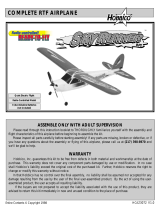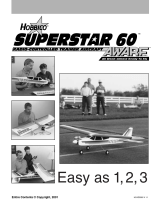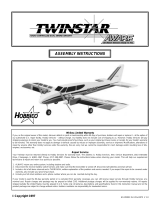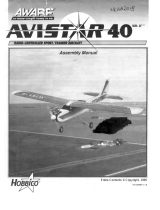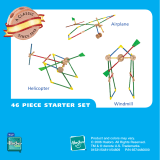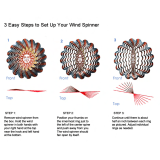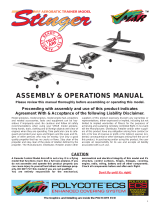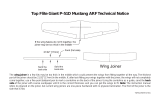
ALMOST READY-TO-FLY RADIO CONTROLLED MODEL AIRPLANE
• SUPERIOR QUALITY IN AN ALMOST-READY-TO-FLY MODEL
• SPECIAL COVERING PROCESS YIELDS A STRONG,
BRILLIANT, AND FUEL-PROOF FINISH
• 90% COMPLETE OUT OF THE BOX—NO SANDING, PAINTING, OR
FINISHING REQUIRED
• SMOOTH, STEADY FLIGHT CHARACTERISTICS, JUST LIKE
A REAL PLANE
• CAPABLE OF FULL 4-CHANNEL AEROBATICS
© ENTIRE CONTENTS COPYRIGHT 1989, HOBBICO, INC. V1 .0

IMPORTANT: BEFORE YOU BEGIN.
Congratulations on your choice of an ASAP kit BEFORE you begin assembly, carefully look through the box and
thoroughly read the instruction manual Also check the parts list against the items in the box to be sure you have
everything that is on the parts list Although we have taken great pains to simplify the building process, there are no
shortcuts to safety These instructions are your guide to safe and successful flying
Only after you are thoroughly familiar with the construction process should you proceed with assembly
REMEMBER! Under no circumstances will a dealer accept a kit back for return if assembly has
already begun.
If the Diabolo 40 is not quite what you expected, return it to your dealer in NEW and UNUSED condition
However, we think you will agree with us that the Diabolo 40 is one of the finest models of its type and will offer you
many hours of enjoyment
BEFORE ASSEMBLY
CONSTRUCTION HINTS:
(1) Trial fit each part before gluing Be certain that the parts fit properly
(2) Use PlastiZap or a thin type Cyanoacrylate glue for installing
the plastic parts Do not use too much as it may run and spoil the
appearance Do not get Cyanoacrylate on the foam parts of the Diabolo
Cyanoacrylate will destroy the foam
(3) It is best to use 30 minute epoxy where required This allows time to
position the parts before the epoxy cures
(4) Before assembly, place your radio system on charge
ADDITIONAL ITEMS
Most engines require a 1.5V glow plug starting battery a glow plug clip and a
quality brand fuel (consult the engine manufacturer's recommendations)
The following items are needed for completing the Diabolo 40 kit
Medium Fuel Tubing (12 ") (1)
40 45 Sized 2 Stroke (1)
or
60 70 Sized 4 Stroke (1)
4 Channel Radio System (1)
Pacer PlastiZap CA Glue (1)
Screw Locking Compound (Pacer Zap Lock) (1)
Goldberg #481 Foam Rubber (1)
30 Minute Epoxy (1)
Silicone Sealer (1)
Dubro 121 E Z Connects (Optional) (2)
Dubro 203 Kwik Switch Mount (Optional) (1)
TOOLS —
You will need the following tools to assemble the Diabolo 40 X Acto knife,
Phillips screwdriver (small and medium) needle nose pliers drill drill bits sand
paper and ruler
A quality brand engine will be needed We recommend the OS 40 FP or 40 SF
2 stroke engine A prop and fuel tubing will be required for the engine
A four channel radio control system with 4 servos is required for the Diabolo 40
The various components are pictured above
-2-

PARTS LIST
Before assembly match the parts in the
exploded view of the Diabolo with the
parts in the kit. Check off each part on
the parts list. If any parts are missing or
damaged return the kit to your hobby
dealer.
Check to make sure that all the listed
parts are included in your kit.
1 Fuselage
2 Right Wing
3 Left Wing
4 Wing Center Cover (Plastic)
5 Vertical Fin
6 Rudder
7 Horizontal Stabilizer (Stab.)
8 Cowl
9 Fuel Tank
10 Neoprene Ring
11 Plastic Disc (Small)
12 Plastic Disc (Large)
13 Silicone Tubing
14 Clunk
15 3x18mm Self Tapping Screw
16 Rubber Plug
17 Plastic Collar
Aileron Horn
Control Horns
Snap Clevis
Rod Clevis
Back Plates
18 Fuel Pipe
19 Mounting Plates (Angled)
Mounting Plates (Rectangle)
20 Clevis Retaining Tube
21 Push Rod Exits
22 Stab. Root Cover (Plastic)
23 Wheel
24 Main Gear
25 Wheel Pants
26 Cock Pit
27 Canopy
28 Main Wing Joiner
29 Rear Wing Joiner
30 Front Wing Joiner
31 Rubber Shock Absorber
32 Cowl Brace
33 Aileron Servo Tray Mount
34 Aileron Servo Tray
35 8mm Dowel Rod
36 Wing Bolt Mounting Block
37 Balsa Tank Support
38 Wing Mounting Brace
39 3x12mm Self Tapping Screw
Spinner
Spinner Back Plate
40 Engine Mount
41 Mounting Plates
42 Shrink Tubing
43 Control Rod (Short-Bent)
44 Aileron Control Rods (Short)
45 Throttle Control Rod (Long)
46 Throttle Tube
47 Wood Push Rods
48 Control Rod (Long)
49 Main Servo Tray
50 Stabilizer Supports
51 Plastic Disc
52 Cock Pit Mounts
53 Brass Sleeve
Brass Tube
54 Tail Wheel
55 Spring Steel Strip
56 Tail Gear
57 Tail Control Arm
58 Springs
59 Brass Arms
60 0-Ring
61 Collars
62 Wheel Collar
63 4x40mm Screw
64 4x30mm Screw
65 2x15mm Screws
66 3x8mm Self Tapping Screw
67 3x8mm Screw
68 3x12mm Self-Tapping Screw
69 3x5mm Screw
70 3.5x15mm Screw
3x12mm Screw
71 4x15mm Screw
72 4x20mm Screw
73
4mm
Nut
74
2mm
Nut
75
3mm
Nut
76 4mm Washer
77 3mm Washer
78 2mm Washer
79 Lock Washers
80 4mm Washer
81 4mm Nylon Nut
82 1/8" Plywood Wedge
-3-

WING ASSEMBLY
(A) Right Wing (Aileron Installed) ... 1
(B) Left Wing (Aileron Installed) .... 1
(C) Main
Wing
Joiner
.........
2
(D)
Rear
Wing
Joiner
........
1
(E)
Front
Wing
Joiner
.........
1
(F) Wing Center Cover (Plastic) .... 1
(G)
8mm
Dowel
Rods
.........
2
(H) Wing Bolt Mounting Block ..... 1
(3) Remove the foam covering from the aileron servo mounting area. Test fit the
main wing joiner and the rear wing joiner in the right and left wing sections. The
dihedral angle of the joiners should make the wing tips slightly higher than the
center.
(I)
Wing
Mounting
Brace
........
1
(J)
4x30mm
Bolts
........
.2
(K)
4mm
Washer
..........
.2
(L) 0-Ring . ............ .2
(M) Aileron Servo Tray ......... 1
(N) Aileron Servo Tray Mount ..... 1
(0)
Main
Servo Tray
..........
1
(1) Check each wing half for smooth aileron operation. It is a good ideal to exercise
(move back and forth) the ailerons to insure easy deflection. Sand the end if any
rubbing is noticed.
(4) Make sure that there is no gap between the wing halves. If there is, sand the wing
joiner ends until there is a tight fit.
(2) Align and epoxy the two main wing joiners together. Hold tight until the glue sets.
You'll notice that there is dihedral angle cut into the joiners so make sure they are
perfectly lined up.
(5) Apply epoxy to one half of one side of both the main and rear wing joiners and
glue them to one wing half. Make sure the dihedral angle is correct and that they
are slid in all the way.
-4-

(6) After the joiners have dried, apply epoxy where shown. The wing roots, the
wing joiners and inside the other wing joiner slot should be evenly covered with
epoxy.
(9) Drill two 8mm holes into the wing joiners for the dowel rods.
(7) Slide the two wing halves together slowly and wipe off any excess glue. Hold
the two wing halves firmly together with tape until the epoxy has cured.
(10)
Epoxy the
Iwo
dowel
rods
into
the
holes.
Make sure they are
all
the way
in.
(8) Once dry, remove the tape. Position the front joiner as shown. The flat edge of
the joiner should line up with the top of the wing. next, remove and epoxy in
that same position Let cure.
(11) Position the wing center cover on the bottom of the wing. Apply Cyanoacrylate
glue under the edges and hold until it dries.
-5-

(12) Epoxy in the main servo tray where shown
(15) Screw in the wing bolts half way into the wing bolt mounting block Apply ink
or paint to the heads of the two bolts Next center the wing and set it onto the
bolts This will mark where you need to drill
(13) Test fit the wing bolt mounting block to the inside of the fuselage The blind
nuts should face down
(16) After the epoxy has cured place the wing into the fuselage as shown Put the
front in first aligning the dowel rods in the holes Once in place lower the back
into position
(14) Epoxy the wing bolt mounting block in This is a high stress point and extra
care should be taken to ensure a strong joint
(17) Place the wing mounting brace onto the wing as shown and center the wing
and brace with the fuselage NOTE The two indentations on the brace should
face up PlastiZap it on
-6-

(18) Drill two 4mm holes 90° from the top wing surface for the wing bolts where
the paint marks are.
(21) Epoxy the aileron servo tray mount into the rear section of the wing servo
mount and then epoxy in the tray.
COCKPIT/CANOPY ASSEMBLY
(19) Assemble the wing bolts as shown (bolt — washer — wing — o-ring) and
temporarily fasten down the wing. Check for good fit and then remove.
(A)
Cockpit,
....................................
.1
(B)
Canopy
.....................................
.1
(C)
Cockpit Mounts
................................
.4
(D) 3x8mm Self-Tapping Screws .......................... .4
(20) Trial fit the aileron servo tray mount and tray to the wing. NOTE: The front
edge should
be
on the
wood,
therefore,
you
will
have
to
trim
away
a
little
covering for a good fit.
(1) Epoxy the four cockpit mounts to the fuselage as shown. Be careful when
gluing the rear mounts to only glue them to the wing mounting brace.
-7-

LANDING GEAR INSTALLATION
(2) Once the epoxy has cured, position the cockpit on the fuselage Make 4 small
holes where cockpit mounts are located Attach with the 4 small self-tapping
screws Do not glue the cockpit
(A)
Main
Gear
......
.1
(B) Rubber Shock Absorber. ..... .1
(C)
4mmx30mm
Screw
.......
.2
(D) 4mm
Washer
.......
.4
(E) 4mm Nut .... ...... .6
(F)
4mm Nylon
Nut..........
.2
(G) Wheel
.............
.2
(H) Wheel Pants . . .2
(1) 4mmx40mm Screw . . .2
(J)
3mmx12mm Screw
........
.2
(K)
3mm
Washer
.........
.2
(L) 3mm Nut .......... .2
(M) Plastic Collar ..... ..... .2
(3) Trail fit the canopy to the cockpit If necessary, trim for a perfect fit Apply a thin
bead of Cyanoacrylate glue to the cockpit and attach and hold the canopy until
(1) Remove the cockpit and the wing Place the two 4mmx40mm screws with the
4mm washers into the two landing gear holes that are located inside of the front
fuselage section
(4) Apply the black striping tape to the edge around the canopy.
(2) Thread two 4mm nuts onto the two screws and tighten Next place the rubber
shock absorber over the screws.
-8-

(3) Now place the main gear (angled side facing back) over the screws and secure
it with two 4mm nylon nuts NOTE tighten the nuts all the way and then
loosen them both one turn This will give the gear the correct shock absorbing
qualities
(6) Place the 3mm screw/washer into the top hole of the wheel pants from the
inside And then attach it to the top hole of the main gear using the 3mm nut
(4) Next take the two wheel pants and drill two holes in each one The first hole
should be at the indent (4mm in diameter) The second should be 3/8 above
the first and smaller (3mm diameter)
(7) Flare open the pants and insert the wheel assembly Install the 4mm nut and
tighten holding the inside nut with needle nose pliers
(5) Arrange the above parts as shown and then assemble together Do this twice
Place screw locking compound on the threads when installing the nuts
(8) Make sure that both wheels rotate freely If they do not trim away the plastic as
needed Or if need be, loosen the nuts unscrew the wheel screw, and
retighten
-9-

ENGINE INSTALLATION
(A)
Engine Mount
...............................
.1
(B)
4mmx20mm
Screws
..............................
.4
(C)
Mounting
Plates
..............................
.2
(D)
4mmx15mm
Screws
.............................
.4
(E)
4mm
Washers
.................................
.4
(F)
Lock Washers
.................................
.4
(G)
3.5mm
Screw
.................................
.4
(H)
3.5mm
Nuts
..................................
.4
(3) Hold each mounting plate under one engine mount as shown (Thick side
towards the engine ) Line up the mark with the front hole of the engine mount.
Mark the plates where the engine mounting holes are.
(1) Install the engine mount to the fuselage using (4) 4mmx20mm screws Note
the direction the mount is installed for proper engine positioning Also use
screw locking compound on the screw threads.
(4) Drill two 3.5mm holes in each mounting plate at the marks.
(2) Make a mark 1/2" to 5/8" back from the hole on one end of each mounting
plate using a sharp knife NOTE: When mounting the engine, the thicker
sides of the plates should be mounted facing the engine
(5) Mount the
plates
to the engine using
the
3.5mm
screws and lock washers
up
from the bottom as shown. Next apply screw locking compound to the screw
threads and tighten on the 3.5mm nuts. Now do this to both sides.
-10-

(6) Now mount the engine to the fuselage Use (4) 4mmx15mm screws with the
(4) 4mm washers. Be sure to use screw locking compound on the threads.
(2) Put the self tapping screw in the center hole from the large end and tighten it
only a couple of turns.
FUEL TANK INSTALLATION
(A) Fuel Tank ................................... .1
(B) Clunk
.....................................
.1
(C)
Silicone
Tubing
................................
.1
(D)
Fuel
Pipe
...............................
.3
(1 extra)
(E)
Plastic
Disc (Large)
...............................
.1
(F)
Plastic
Disc (Small)
...............................
.1
(G) 3mmx 18mm
Self
Tapping
Screw.
.......................
.1
(H) Rubber Plug
.................................
.1
(I)
Neoprene Ring
.................................
.1
(J)
Balsa Tank
Support
...............................
.1
(3) Attach the silicone tubing to the centered fuel pipe and attach the clunk to the
other end.
(1) Install two fuel pipes through the rubber plug. One should be halfway through,
the other should be 2/3 through as shown. Next place the two plastic discs
onto each side. The large one should be on the outside.
(4) Carefully bend up the other fuel pipe so it will just touch the inside top of the
fuel tank.
-11-

(5) Attach the complete fuel tank cap to the tank Make sure that the bent pipe is
pointing to the top Slide the cap on until the lip on the fuel tank is in the
groove of the cap. Then tighten the screw.
(8) Install the fuel tank from the inside of the fuselage with the fuel lines facing
front Slide the tank into its mount and up into the hole in front of the fuselage
Make sure that the fuel tubing is through the hole.
(6) Glue the neoprene ring to the tank with silicone sealer Attach two pieces of
fuel tubing (6" each) to the pipes. One is for the carburetor the other is for the
pressure tap on the muffler
(9) Epoxy the tank support to the inside of the front fuselage Once dry apply a
heavy bead of silicone sealer in between the support and the tank.
RADIO INSTALLATION
(A)
Aileron
Horn
.........
2
(B) Wood Push Rods
........
2
(C) Aileron Control Rods (Short) ... 2
(D) Control Rod (Long) .... 3
(E) Control Rod (Short-Bent) . . . . 2
(F)
Shrink
Tubing
..........
1
(G) Throttle Control Rod (Long) ... 1
(H) Snap Clevis ..... 2
(I)
Push Rod
Exits
........
3
(J)
Clevis
Retainer
Tubing
......
1
(K) Throttle
Tube
.
.........
1
(7) Put a bead of silicone sealer on the top of the neoprene ring.
-12-

(1) Check the fit of your aileron servo in the aileron servo tray You may have to
trim away some of the servo tray for a good fit Install the grommets onto the
servo and fasten it to the wing using the screws provided with the radio system
Be sure to leave the wire outside
(4) Attach the clevises to the aileron horns and slide on the retaining tubes After
checking the neutral position of the aileron servo and ailerons, put a mark on
the push rods where the servo arm holes are
(2) Screw the aileron horns onto the aileron control arms Trim the wing mounting
brace as needed for full aileron movement
(5) At the mark, bend each push rod at a right angle
(6) Cut the push rods 6mm from the bend
(3) Screw two snap clevises half way up the threads on the aileron control rods
Next, cut two pieces of the clevis retaining tubing and slide them onto the rods
-13-

(7) Attach the rods to the servo arm using the rod clevis NOTE You may have to
use a different style servo horn for more throw as shown
(10) Install the three remaining servos into the tray using grommets and screws Be
sure that the servos are positioned correctly Next mount the radio switch
NOTE Make sure that the servo wires all run forward so they are easily
accessible
(8) Connect the aileron servo to the receiver and check the movement of the
ailerons Make sure that both ailerons are neutral when the servo is neutral
Adjust the clevises as needed
(11) We suggest installing an external switch mount so that the radio system can
easily be turned on and off from the outside without taking the wing off (The
Dubro #203 Kwik Switch Mount works well)
(9) Trial fit the servos into the fuselage and trim the tray as needed for a good fit (12) Assemble the rudder and elevator control rods using the parts above
-14-

(13) Bend two of the long rods as shown for the elevator and one of the rods for the
rudder
(16) Assemble the push rod as shown Place the two short (pre bent) rods into one
end of each rod with the single grooves Slide a piece of shrink tubing over
each rod and heat with a heat gun or a lighter to shrink the tubing for a tight fit
Place the elevator rods into the double grooved end of one of the rods
(14) Drill a 1/16" hole 2" from the ends (2 holes 1/16" apart on one end of one
rod) of both wood push rods and with a hobby knife Carefully cut straight
grooves from the holes to the ends Only cut a groove on one side of each end,
except for one end of one rod (the one with two holes) For this one end, make
a groove on both side
(17) Next, do the same with the other rod Make sure that each rod fits in a groove
(15) Cut 4 equal (about 2" each) pieces of the white shrink tubing
(18) Punch out the three rod exits at the tail and insert the rudder push rod into the
fuselage from the front and then through the bottom exit on the right side Do
the same with the elevator rod but put those through the top two holes It may
be necessary to bend the rods to fit
-15-

(19) Use PlastiZap and glue the three plastic push rod exits to the fuselage
(22) Install the plastic tubing through the hole in the firewall to the servo tray Epoxy
the tube where it goes in
(20) Check to make sure that the rods will easily move in and out with little
resistance You may have to bend the rods slightly for a perfect fit (We will
connect the rods to the servos after the tail assembly )
(23) Make a "Z" bend on one end of the throttle control rod and insert the opposite
end into the tube
(21) Use the throttle control rod and the white throttle tube for the engine linkage
Lightly sand the plastic tube so the epoxy will adhere to it
(24) Connect the servos to the receiver and battery and center all radio controls
(including the throttle stick and move the servo horns so they are in line with
the servo as shown After they are centered pull the throttle stick back down
(low throttle) Install the straight servo horns
-16-

(25) Connect the "Z" bend to the engine throttle arm. It may be necessary to
remove the arm from the engine for easier installation.
(28) Next, at the marked point, make another "Z" bend, cut off the excess and
attach it to the servo arm. For easy adjustments, an easy connect can be used
here. (Dubro #121 E-Z Connectors work well.)
(26) Epoxy the white tube to the tube guide.
(29) Check for proper radio operation of the throttle. Make sure that the carburetor
will move from low to high completely.
ASSEMBLY OF THE TAIL SECTION
(27) From the inside, pull back the throttle control rod so the carburetor is closed.
Now, mark the rod where it crosses the throttle servo horn (in low position).
(A) Horizontal Stabilizer (Stab) .... .1
(B) Vertical Fin ............ .1
(C)
Rudder
.
............
.1
(D)
1/8"
Plywood Wedge
......
.1
(E) Stab Root Cover (Plastic) ..... .1
(F)
Stab.
Supports
...........
.2
(G)
Plastic
Disc
............
.4
(H)
Brass
Sleeve
...........
.2
(I)
2mmx15mm
Screw
........
.2
(J)2mm Nut ............. .2
(K)
2mm
Washer
...........
.4
(L)
Tail Wheel
........
1
(M) Tail Gear
.............
.1
(N) Tail Control
Arm
.........
.1
(0)
Springs
.............
.2
(P)
Brass
Arms
............
.2
(Q) Spring Steel Strip (Long) ..... .1
(R) 3mmx12mm Self Tapping Screw . .2
(S) 3mmx5mm Screw . . 2
(T)
Wheel Collar
.......
1
(U) Wheel Collar Screw 1
(V)
Brass
Collars
.
.......
2
.17-

(1) Test fit the 1/8" plywood wedge into the tail end of the fuselage. If there is a
good fit, epoxy it in place making sure that it is even with the fuselage sides.
NOTE: It may be necessary to trim away some wood or glue to make the
wedge fit flush.
(4) Next take a piece of string and attach it with a pin to the top center of the
fuselage. Make sure that the stabilizer is centered and stretch the ring to the
corner of the elevator. Adjust the positioning of the stabilizer so that both
corners are the same length when moving the string from side to side.
(2) Trim away part of the plastic rear cover to allow proper fit of the horizontal
stabilizer.
(5) Next, remove the stabilizer and apply epoxy to the wedge. Reinstall the
stabilizer and re-center like before.
(3) Install the main wing. Next place the horizontal stabilizer onto the tail Hold it
on and visually see if the wing and stabilizer are parallel. If not sand the higher
side of the stabilizer mount until the stabilizer is parallel.
(6) Once the horizontal stabilizer epoxy has cured trial fit the vertical fin (without
the rudder) on top of the horizontal stabilizer. Center the fin so it is straight in
line with the fuselage and 90 ° to the stabilizer. Draw a line on both sides of the
fin as shown.
-18-

(7) Next, apply epoxy to the top of the horizontal stabilizer and re-position the fin
between the lines. Make sure that the fin is still 90° to the stabilizer. Do the
next step before the glue sets.
(10) After the glue has completely set, assemble the tail wheel section shown. The
wheel should be straight in line with the strip as should be the tail control arms.
Attach the wheel collar to hold the wheel on.
(8) While the epoxy is still wet. position the plastic stabilizer root cover over the fin.
Double check the positioning of the fin after doing this.
(11) Carefully turn over the airplane and attach the 3mmx12mm self-tapping screws
into the center of the fuselage so that the end of spring steel strip is 2 1/2" from
the
end.
(9) When satisfied with the fin positioning, apply Cyanoacrylate glue to the
underside edge of the stabilizer root cover and install in place.
(12) Now take the stabilizer supports and bend the ends as shown above.
-19-

(13) Attach the two supports onto the fuselage with a 3mmx12mm self tapping
screw Make sure that the tail wheel assembly is straight
(16) Next, drill a 2mm hole about 1" deep at 1 1/8" from the bottom of the
rudder The hole should be straight in from the front edge
(14) Position the supports straight out (90°) to the fuselage and attach Use the
included hardware and drill 2mm holes for mounting
(17) Notch a small groove (1/8" deep) from the hole down to the bottom for the
tail control arm
(15) Trial fit the rudder onto the vertical fin Notice where the bottom hinge meets
the fuselage and make a slot in the tail where the rudder hinge needs to be with
an X Acto knife
(18) Place a small amount of epoxy on the hinges, in the groove and on the end of
the tail control arm (It is a good idea to place some petroleum jelly onto the
hinge center joint (point of movement) to keep out any epoxy
20-
Page is loading ...
Page is loading ...
Page is loading ...
Page is loading ...
Page is loading ...
Page is loading ...
Page is loading ...
Page is loading ...
/

